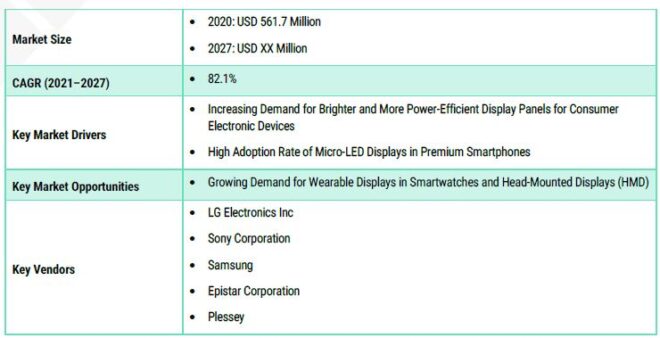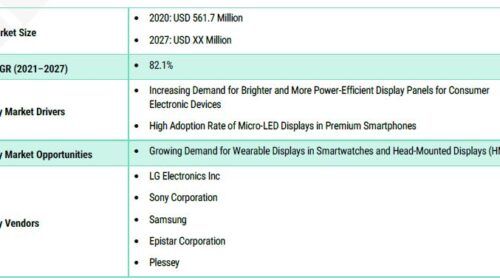Global Micro LED display Market Impressively Grow at CAGR of 82.1% though Covid-19 Impacts
Global Micro LED display Market
What are Micro LED displays?
Micro-LED is a technology used in displays consisting of microscopic light-emitting diodes of different colors arranged into an array. Micro-LED is also known as micro-LED, mLED, or µLED. An LED display technology features several tiny pixels. Micro-LED is a true LED emitter such as OLED and plasma rather than the backlight source in an LCD/LED TV.
Micro-LED displays are a type of display in which each pixel comprises a series of minuscule light-emitting diodes (LEDs). These displays provide excellent wavelength uniformity. Compared with OLEDs and LCDs, micro-LED displays offer advantages such as lower power consumption, enhanced brightness, ultrahigh definition picture quality, improved color saturation, and a faster response time.
Increasing demand for brighter and more power-efficient display panels for consumer electronic devices and the adoption rate of micro-LED displays in premium smartphones are anticipated to boost the market growth.
However, the lack of standard procedures for manufacturing micro-LED display components hampers the market growth. Furthermore, the growing demand for wearable displays for smartwatches and head-mounted displays (HMD) is expected to create opportunities for the global voice assistant market players
Global Micro LED display Market Trend
“The global micro LED display market size was valued at USD 561.7 million in 2020. It is expected to expand at a compound annual growth rate (CAGR) of 82.1% from 2021 to 2027.” according to the latest market research: Micro-LED Display Market—Forecast till 2027
Micro LED Display Market Synopsis

Source: Micro-LED Display Market—Forecast till 2027
How can Micro LED display Market be segmented?
The global micro-LED display market has been segmented on the basis of application, panel size, verticals, and region.
Based on application, the micro-LED display market is segmented into smartphones & tablets, NTE devices, televisions, monitors & laptops, digital signage, smartwatches, and heads-up display.
By panel size, the micro-LED display market is segmented into micro-displays, large panels, and small and medium-sized panels. Based on end user, the micro-LED display market is segmented into individual users, large enterprises, and SMEs.
Based on vertical, the micro-LED display market is segmented into consumer electronics, entertainment & advertisement, automotive, aerospace & defense, and others
Who are key players on Micro LED display Market?
The key players operating in the global micro-LED display market include LG Electronics Inc, X-Celeprint, Epistar Corporation, Nanosys Inc., eLux, Inc., JBD, Aledia, Sony Corporation, Samsung Electronics, Plessey, and PlayNitride Inc, are the leading providers of voice assistance service in the market. The key factor driving the micro-LED display market growth is the increasing use of emerging advanced technologies.
LG ELECTRONICS INC (FOR REFERENCE ONLY)
Company Headquarters: South Korea
Founded: 1958
Workforce: ~75,000
Webiste: www.lg.com
Company Working: LG Electronics Inc is a manufacturer and distributor of electrical equipment. The company operates through seven segments, which are home appliances & air (H&A) solutions, home entertainment (HE), mobile communications (MC), vehicle component solutions (VS), business solutions (BS), LG Innotek, and other.
The home appliances & air (H&A) solutions segment comprises refrigerators, washing machines, air conditioners, microwave ovens, cleaners, and others. The home entertainment (HE) segment provides televisions (TVs), monitors, personal computers (PCs), audio, and videos. The mobile communication (MC) segment provides mobile terminal equipment.
LG Innotek Co Ltd (Innotek) and its subsidiaries supply camera modules, substrate materials, motors, sensors, and light-emitting diodes (LEDs). The vehicle component solutions (VS) segment produces car parts.
The business solutions (BS) segment offers information displays and solar panels. The company has a strong presence across South Korea, China, Russia, and several countries across North America, Asia-Pacific, Europe, South America, the Middle East & Africa.
What factors can drive the Micro LED display Market?
INCREASING DEMAND FOR BRIGHTER AND MORE POWER -EFFICIENT DISPLAY PANELS FOR CONSUMER ELECTRONIC DEVICES
Due to the rapid emergence and availability of new technologies, the consumer electronics industry is one of the fastest-growing industries in the world. Rapid technological developments to meet customer needs will offer business possibilities.
Consumer gadgets such as smartphones and laptops are becoming more popular in developed and developing countries due to rising per capita disposable income, high population growth, and Internet penetration. Several economies have seen an increase in the penetration of these gadgets because of ongoing critical technical advances.
Smartphones, tablets, desktop monitors, TVs, data projectors, and augmented reality/virtual reality devices are all examples of the broad application scope or display technologies. Consumer demand for increasingly technologically complex items necessitates the inclusion of superior electronic displays in devices.
The two most common flat panel display technologies are liquid crystal displays (LCDs) and organic light-emitting diode (OLED) displays. LCDs have replaced large and heavy cathode ray tubes (CRTs) as the dominating technology since the 2000s. However, they are permissive and require a backlight unit (BLU), which increases the screen thickness while also limiting flexibility and form factor.
Meanwhile, the adoption of organic light-emitting diode (OLED) displays has expanded rapidly following 30 years of rigorous material and device development and considerable investments in advanced production processes, enabling the production of folding smartphones and rollable TVs.
Due to their superior unparalleled dark state, thin profile, and freeform factor, emissive OLED displays have gained traction in recent years and have fiercely fought with LCDs in TVs and smartphones.
However, there are still some crucial difficulties to be addressed, such as burn-in and longevity. Micro-LEDs (μLEDs) and mini-LEDs (mLEDs) have recently appeared as next-generation displays; the former is especially appealing for transparent displays and high brightness displays, whereas the latter can serve as a locally dimmable backlight for high dynamic range (HDR) LCDs or as emissive displays.
mLEDs and μLEDs both offer incredibly high brightness and long lives. Sunlight-readable displays, such as cell phones, public information displays, and car displays, benefit significantly from these properties.
Each technology has its own set of benefits and drawbacks, but when it comes to displaying power efficiency, one stands out significantly. The growing demand for brighter, more power-efficient display panels for smartwatches, smartphones, televisions, and AR/VR devices is likely to propel micro-LED display technology development and commercialization.
The keen interest of tech giants such as Apple, Samsung, and Sony in micro-LED display technology is expected to hasten the commercialization of the technology.
For instance, Samsung and Sony are focusing on large-panel signage and television applications, while Apple is more likely to commercialize the technology for wristwatch applications. Moreover, the adoption of micro-LED displays is also anticipated to increase due to continued research by input suppliers to establish a solid supply chain.
Thus, the increasing demand for brighter and more power-efficient display panels for consumer electronic devices is expected to drive the growth of the global micro-LED display market during the forecast period.
What objectives are Micro-LED Display Market—Forecast till 2027?
To provide a comprehensive analysis of the micro LED display market and its sub-segments in the global market, thereby providing a detailed structure of the industry
To provide detailed insights into factors driving and restraining the growth of the global micro-LED display market
To estimate the market size of the global micro LED display market where 2018-2019 would be the historical period, 2020 shall be the base year, and 2021 to 2027 will be the forecast period for the study
To analyze the global micro LED display market in four main geographies, namely, North America, Europe, Asia-Pacific, and the Rest of the World
To provide country-wise market value analysis for various segments of the micro-LED display market
To provide strategic profiling of key companies present across the globe and comprehensively analyze their competitiveness/competitive landscape in this market
To provide a value chain for the micro LED display market

